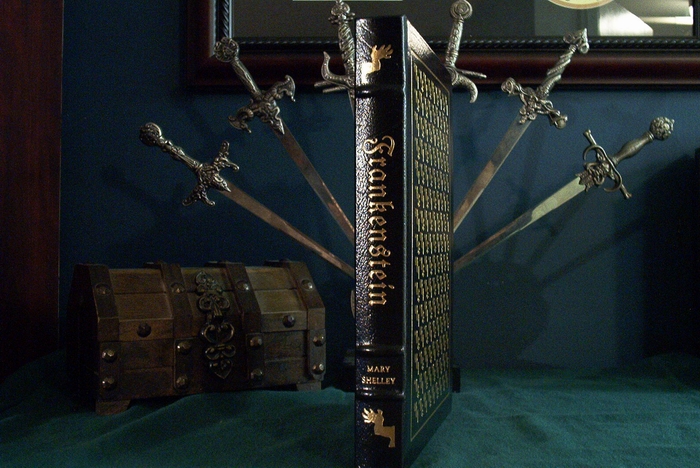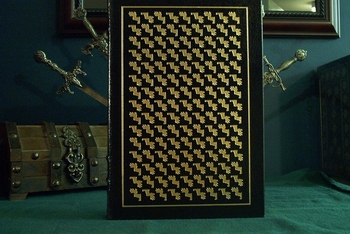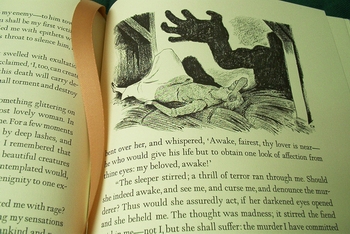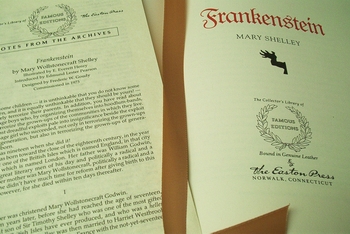Frankenstein, or, The Modern Prometheus is an 1818 novel written by Mary Shelley at the age of 19, first published anonymously in London, but more often known by the revised third edition of 1831 under her own name. The title refers to a scientist who learns how to reanimate flesh and creates a being in the likeness of man out of body parts taken from the dead. In modern popular culture, people have tended to refer to Frankenstein's monster as "Frankenstein" (especially in films since 1930).
It is a novel infused with some elements of the Gothic novel and the Romantic movement. It was also a warning against the "over-reaching" of modern man and the Industrial Revolution, alluded to in the novel's subtitle, The Modern Prometheus. The story has had an influence across literature and popular culture and spawned a complete genre of horror stories and films.
Plot Summary
The novel opens with Captain Walton on his ship sailing north of the Arctic Circle. Walton's ship becomes ice-bound and he spots a figure traveling across the ice on a dog sled. This is Victor Frankenstein's creature. Soon after, he sees the ill Victor Frankenstein himself, and invites him onto his ship. The narrative of Walton is a frame narrative that allows for the story of Victor to be related. At the same time, Walton's predicament is symbolically appropriate for Victor's tale of displaced passion and brutalism.
Victor takes over telling the story at this point. Curious and intelligent from a young age, he learns from the works of the masters of Medieval alchemy, reading such authors as Albertus Magnus, Cornelius Agrippa and Paracelsus and shunning modern Enlightenment teachings of natural science. He leaves his beloved family in Geneva, Switzerland to study in Ingolstadt, Bavaria, Germany, where he is first introduced to modern science. In a moment of inspiration, combining his new-found knowledge of natural science with the alchemic ideas of his old masters, Victor perceives the means by which inanimate matter can be imbued with life. He sets about constructing a man using means that Shelley refers to only vaguely. He hopes to be the God of a new race of creatures that he created. The main idea seems to be that Victor built a complete body from various organic human parts, then simulated the functions of the human system in it. In the novel it is stated (chapter 4, volume 1) that he uses bones from charnel houses (repositories for the bones or bodies of the dead), and
"The dissecting room and the slaughterhouse furnished many of my materials; and often did my human nature turn with loathing from my occupation, whilst, still urged on by an eagerness which perpetually increased, I brought my work near to a conclusion."
Victor intended the creature to be beautiful, but when it awakens he is disgusted. As Victor used corpses as material for his creation, it has yellow, watery eyes, translucent skin, black pupils, hair and lips and around 8 feet in height. Victor finds this revolting and runs out of the room in terror. That night he wakes up with the creature at his bedside facing him with an outstretched arm, and flees again, whereupon the creature disappears. Shock and overwork cause Victor to take ill for several months. After recovering, in about a year's time, he receives a letter from home informing him of the murder of his youngest brother. He departs for Switzerland at once.
Victor takes over telling the story at this point. Curious and intelligent from a young age, he learns from the works of the masters of Medieval alchemy, reading such authors as Albertus Magnus, Cornelius Agrippa and Paracelsus and shunning modern Enlightenment teachings of natural science. He leaves his beloved family in Geneva, Switzerland to study in Ingolstadt, Bavaria, Germany, where he is first introduced to modern science. In a moment of inspiration, combining his new-found knowledge of natural science with the alchemic ideas of his old masters, Victor perceives the means by which inanimate matter can be imbued with life. He sets about constructing a man using means that Shelley refers to only vaguely. He hopes to be the God of a new race of creatures that he created. The main idea seems to be that Victor built a complete body from various organic human parts, then simulated the functions of the human system in it. In the novel it is stated (chapter 4, volume 1) that he uses bones from charnel houses (repositories for the bones or bodies of the dead), and
"The dissecting room and the slaughterhouse furnished many of my materials; and often did my human nature turn with loathing from my occupation, whilst, still urged on by an eagerness which perpetually increased, I brought my work near to a conclusion."
Victor intended the creature to be beautiful, but when it awakens he is disgusted. As Victor used corpses as material for his creation, it has yellow, watery eyes, translucent skin, black pupils, hair and lips and around 8 feet in height. Victor finds this revolting and runs out of the room in terror. That night he wakes up with the creature at his bedside facing him with an outstretched arm, and flees again, whereupon the creature disappears. Shock and overwork cause Victor to take ill for several months. After recovering, in about a year's time, he receives a letter from home informing him of the murder of his youngest brother. He departs for Switzerland at once.
Near Geneva, Victor catches a glimpse of the creature in a thunderstorm among the rocky boulders of the mountains, and is convinced that it killed his younger brother, William. Upon arriving home he finds Justine, the family's beloved maid, framed for the murder. To Victor's surprise, Justine makes a false confession because her minister threatens her with excommunication. Despite Victor's feelings of overwhelming guilt, he does not tell anyone about his horrid creation and Justine is convicted and executed. To recover from the ordeal, Victor goes hiking into the mountains where he encounters his "cursed creation" again, this time on the Mer de Glace, a glacier above Chamonix.
The creature converses with Victor and tells him his story, speaking in strikingly eloquent and detailed language. He describes his feelings first of confusion, then rejection and hate. He explains how he learned to talk by studying a poor peasant family through a chink in the wall. He performs in secret many kind deeds for this family, but in the end, they drive him away when they see his appearance. He gets the same response from any human who sees him. The creature confesses that it was indeed he who killed William (by strangulation) and framed Justine, and that he did so out of revenge. But now, the creature only wants companionship. He begs Victor to create a synthetic woman (counterpart to the synthetic man), with whom the creature can live, sequestered from all humanity but happy with his mate.
At first, Victor agrees, but later, he tears up the half-made companion in disgust and madness due to the thought that the Creature might create children. In retribution, the creature kills Clerval, Victor's best friend, and later, on Victor's wedding night, his wife Elizabeth. Victor's father later dies of grief. Victor now becomes the hunter: he pursues the creature into the Arctic ice, though in vain. Near exhaustion, he is stranded when an iceberg breaks away, carrying him out into the ocean. Before death takes him, Captain Walton's ship arrives and he is rescued.
The creature converses with Victor and tells him his story, speaking in strikingly eloquent and detailed language. He describes his feelings first of confusion, then rejection and hate. He explains how he learned to talk by studying a poor peasant family through a chink in the wall. He performs in secret many kind deeds for this family, but in the end, they drive him away when they see his appearance. He gets the same response from any human who sees him. The creature confesses that it was indeed he who killed William (by strangulation) and framed Justine, and that he did so out of revenge. But now, the creature only wants companionship. He begs Victor to create a synthetic woman (counterpart to the synthetic man), with whom the creature can live, sequestered from all humanity but happy with his mate.
At first, Victor agrees, but later, he tears up the half-made companion in disgust and madness due to the thought that the Creature might create children. In retribution, the creature kills Clerval, Victor's best friend, and later, on Victor's wedding night, his wife Elizabeth. Victor's father later dies of grief. Victor now becomes the hunter: he pursues the creature into the Arctic ice, though in vain. Near exhaustion, he is stranded when an iceberg breaks away, carrying him out into the ocean. Before death takes him, Captain Walton's ship arrives and he is rescued.
Walton assumes the narration again, describing a temporary recovery in Victor's health, allowing him to relate his extraordinary story. However, Victor's health soon fails, and he dies. Unable to convince his shipmates to continue north and bereft of the charismatic Frankenstein, Walton is forced to turn back towards England under the threat of mutiny. Finally, the creature boards the ship and finds Victor dead, and greatly laments what he has done to his maker. He vows to commit suicide. He leaves the ship by leaping through the cabin window onto the ice, and is never seen again.
The creature
Part of Frankenstein's rejection of his creation is the fact that he doesn't give it a name, which gives it a lack of identity. Instead it is referred to by words such as 'monster', 'creature', 'demon', 'fiend', and 'wretch'. When Frankenstein converses with the monster in chapter 10, he addresses it as 'Devil', 'Vile insect', 'Abhorred monster', 'fiend', 'wretched devil' and 'abhorred devil'.During a telling she did of Frankenstein, she referred to the creature as "Adam". It is not known for sure, but it is likely that Shelley is referring to the first man in the Garden of Eden here, as her epigraph:
'Did I request thee, Maker from my clay
To mould Me man? Did I solicit thee
From darkness to promote me?'
- (X.743-5), John Milton's Paradise Lost.
The monster has often been mistakenly called "Frankenstein". In 1908 one author said "It is strange to note how well-nigh universally the term "Frankenstein" is misused, even by intelligent persons, as describing some hideous monster...". Edith Wharton's The Reef (1916) describes an unruly child as an "infant Frankenstein." David Lindsay's "The Bridal Ornament," published in The Rover, June 12, 1844, said "...from their Promethean fingers, which beat the maker of poor Frankenstein all to nothing...". After the release of James Whale's popular 1931 film Frankenstein, the public at large began speaking of the monster itself as "Frankenstein". A reference to this occurs in Bride of Frankenstein (1935) and in several subsequent films in the series, as well as in film titles such as Abbott and Costello Meet Frankenstein.
Some justify referring to the Creature as "Frankenstein" by pointing out that the Creature is, so to speak, Victor Frankenstein's offspring. Also, one might say that the monster is the invention of Doctor Frankenstein, and inventions are often named after the person who invented them (the Hoover vacuum, for instance). Another interpretation is that it is Frankenstein himself who is the monster, because of his savage rejection of the being he created. Although Victor has very few pangs of conscience regarding his duty towards the creature he brought to life, it is his undeserved neglect that causes the creature to turn to evil. In a moral, if not actual sense, it is indeed Victor who is the monster.
Frankenstein Name
Mary Shelley always maintained that she derived the name "Frankenstein" from a dream-vision, yet despite these public claims of originality, the name and what it means has been a source of many speculations. Literally, in German, the name Frankenstein means stone of the Franks. The word "frank" means also "free" in the sense of "not being subject to". Frankenstein is the German name of Ząbkowice Śląskie, a city in Silesia, Poland. There is a town called Frankenstein and Burg Frankenstein (Frankenstein Castle) near Darmstadt which Shelley had seen whilst on a boat before writing the novel. Moreover Frankenstein is a common family name in Germany. More recently, Radu Florescu, in his book In Search of Frankenstein, argued that Mary and Percy Shelley visited Castle Frankenstein on their way to Switzerland, near Darmstadt along the Rhine, where a notorious alchemist named Konrad Dippel had experimented with human bodies, but that Mary suppressed mentioning this visit, to maintain her public claim of originality. A recent literary essay[5] by A.J. Day supports Florescu's position that Mary Shelley knew of, and visited 'Burg Frankenstein'[6] before writing her debut novel. Day includes details of an alleged description of the Frankenstein castle that exists in Shelley's 'lost' journals. However, this theory is not without critics; Frankenstein expert Leonard Wolf calls it an "unconvincing....conspiracy theory".Victor
A possible interpretation of the name Victor derives from the poem Paradise Lost by John Milton, a great influence on Shelley (a quotation from Paradise Lost is on the opening page of Frankenstein and Shelley even allows the monster himself to read it). Milton frequently refers to God as "the Victor" in Paradise Lost, and Shelley sees Victor as playing God by creating life. In addition to this, Shelley's portrayal of the monster owes much to the character of Satan in Paradise Lost; indeed, the monster says, after reading the epic poem, that he sympathizes with Satan's role in the story.Victor was also a pen name of Percy Shelley's, as in the collection of poetry he wrote with his sister Elizabeth, Original Poetry by Victor and Cazire.[8] There is speculation that one of Mary Shelley's models for Victor Frankenstein was Percy, who at Eton had "experimented with electricity and magnetism as well as with gunpowder and numerous chemical reactions," and whose rooms at Oxford were filled with scientific equipment.
Modern Prometheus
The Modern Prometheus is the novel's subtitle (though some modern publishings of the work now drop the subtitle, mentioning it only in an introduction). Prometheus, in some versions of Greek mythology, was the Titan who created mankind, and Victor's work by creating man by new means obviously reflects that creative work. Prometheus was also the bringer of fire who took fire from heaven and gave it to man. Zeus eternally punished Prometheus by fixing him to a rock where each day a predatory bird came to devour his liver, only for the liver to return again on the next day; ready for the bird to come again.Prometheus was also a myth told in Latin but was a very different story. In this version Prometheus makes man from clay and water, again a very relevant theme to Frankenstein as Victor rebels against the laws of nature and as a result is punished by his creation.
Prometheus' relation to the novel can be interpreted in a number of ways. For Mary Shelley on a personal level, Prometheus was not a hero but a devil, whom she blamed for bringing fire to man and thereby seducing the human race to the vice of eating meat (fire brought cooking which brought hunting and killing)[10] For Romance era artists in general, Prometheus' gift to man compared with the two great utopian promises of the 18th century: the Industrial Revolution and the French Revolution, containing both great promise and potentially unknown horrors.
Byron was particularly attached to the play Prometheus Bound by Aeschylus, and Percy Shelley would soon write Prometheus Unbound. The term "Modern Prometheus" was actually coined by Immanuel Kant, referring to Benjamin Franklin and his then recent experiments with electricity.
Publication
Mary Shelley completed her writing in May 1817, and Frankenstein, or The Modern Prometheus was first published on 1 January 1818 by the small London publishing house of Harding, Mavor & Jones. It was issued anonymously, with a preface written for Mary by Percy Bysshe Shelley and with a dedication to philosopher William Godwin, her father. It was published in an edition of just 500 copies in three volumes, the standard "triple-decker" format for 19th century first editions. The novel had been previously rejected by Percy Bysshe Shelley's publisher Charles Ollier and by Byron's publisher John Murray.Critical reception of the book was mostly unfavourable, compounded by confused speculation as to the identity of the author. Walter Scott wrote that "upon the whole, the work impresses us with a high idea of the author's original genius and happy power of expression", but most reviewers thought it "a tissue of horrible and disgusting absurdity" (Quarterly Review).
Despite the reviews, Frankenstein achieved an almost immediate popular success. It became widely known especially through melodramatic theatrical adaptations — Mary Shelley saw a production of Presumption; or The Fate of Frankenstein, a play by Richard Brinsley Peake, in 1823. A French translation appeared as early as 1821 (Frankenstein: ou le Prométhée Moderne, translated by Jules Saladin).
The second edition of Frankenstein was published on 11 August 1823 in two volumes (by G. and W. B. Whittaker), and this time credited Mary Shelley as the author.
On 31 October 1831, the first "popular" edition in one volume appeared, published by Henry Colburn & Richard Bentley. This edition was quite heavily revised by Mary Shelley, and included a new, longer preface by her, presenting a somewhat embellished version of the genesis of the story. This edition tends to be the one most widely read now, although editions containing the original 1818 text are still being published. In fact, many scholars prefer the 1818 edition. They argue that it preserves the spirit of Shelley's original publication (see Anne K. Mellor's "Choosing a Text of Frankenstein to Teach" in the W. W. Norton Critical edition).
The revised edition was changed in several significant ways: any indication that Frankenstein's monster was created by vice was removed, and the text details a benevolent creator who creates the monster merely for the purposes of science. Suggestions of an incestuous relationship between Victor and Elizabeth are also removed, by making Elizabeth an adopted child of the Frankensteins.
Source and additional information: Frankenstein




Comments
Post a Comment
Share your best book review and recommendation